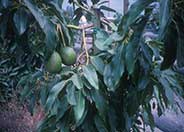
Common name:Avocado, Palta
Botanical name:Persea americana
This is a large tree that can grow as large as an oak. Its exotic, semi-tropical, drupe fruit is famous for making guacamole dip. Frost damages this plant.
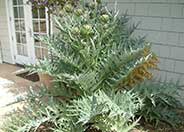
Common name:Artichoke
Botanical name:Cynara scolymus
This perennial will grow 4' tall and 6'-8' wide. It has silvery green leaves with bluish purple flowers that bloom in spring. Artichoke is a favorite fruit/vegetable of California kitchens but it is a great ornamental plant often overlooked for color contrast. It is very tolerant of little water when planted for ornamental purposes.

Common name:Iceland Poppy
Botanical name:Papaver nudicaule
This Iceland Poppy produces leaves that are divided with flowers, appearing on stems 1'-2' high. These flowers are cup-shaped to 3" across, and come in colors of yellow, orange, salmon, rose, pink and cream.

Common name:Sunburst Coreopsis
Botanical name:Coreopsis grandiflora
The 'Double Sunburst' is a wonderful cultivar and a showy, Southeast U.S. native. Golden yellow, double flowers on 2' bushy plants bloom during spring in full sun and average to dry soils. It makes for good cut flowers, and pruning keeps the plants abundant with blooms.
Maintenance Tips
Coreopsis grandiflora is a clumping evergreen perennial with very showy flowers that emerge in spring. This is a very drought-tolerant plant that will look and perform its best in full sun and well-drained soil. It grows 2-3’ tall and 1-2’ wide, so can be used in just about any space in any sized garden without having to prune to maintain the size. This plant rarely has any pest problems, but it is susceptible to some fungal infections, usually brought on by wet conditions in poorly drained soils. This plant will benefit from some fertilizer to keep it looking and performing its best. Deadheading is the best way to keep the plant blooming throughout the year. As soon as the flowers fade and seeding begins, the look and the health of the plant can decline. Once this happens, the plant can be cut back hard to invigorate and encourage new growth.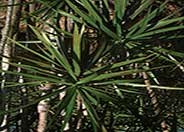
Common name:Red-Edged Chevron Plant
Botanical name:Dracaena marginata
This shrub will grow 6'-12' tall and has large, evergreen, leathery greenish red leaves.
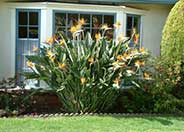
Common name:Bird Of Paradise
Botanical name:Strelitzia reginae
This shrub will grow to 6' tall and has large, gray green fronds with orange, blue, white, or multi-colored flowers that bloom throughout the year.

Common name:Bitsy Hybrid Daylily
Botanical name:Hemerocallis 'Bitsy'
This Daylily has yellow flowers in profusion for over 250 days per year. Thin stalks give an airy, fairy-like quality. Tiny 2" lemon-yellow blossoms appear very early in the season above 12"-20" tall slender, grassy foliage
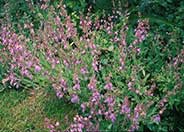
Common name:Garden or Common Sage
Botanical name:Salvia officinalis
This shrubby perennial will grow 1'-3' tall and 1'-2.5' wide. It has gray green leaves that are white and hairy underneath and clusters of bluish purple flowers that bloom in late spring and summer.

Common name:Mealy Cup Blue Sage
Botanical name:Salvia farinacea
This low growing perennial reach 1-1/2' x 1-1/2'. Bright green leaves are lighter underneath. Spiked blue-purple flowers bloom from late spring to fall. Attracts hummingbirds.

Common name:Beach Strawberry, Coastal Strawberr
Botanical name:Fragaria chiloensis
This perennial grows 4"-8" high with tooth-edged leaves and ornamental strawberries during the fall. Cut back or mow in early spring to encourage new growth.
Maintenance Tips
Fragaria chiloensis is a lovely ground cover that is also known as Coastal Strawberry. It is a very well-behaved ground cover, requiring very little maintenance to keep it looking and performing its best. It is best known for its berries which are very attractive to birds and other wildlife. The plant rarely grows taller than 4-6" and spreads out through its root system, creating a dense mat. The plant is susceptible to many types of fungi because of the moisture and the lack of airflow in its dense environment. Treating the plant with a systemic or topical fungicide may be necessary if the infection is killing the plant. Thatching the ground cover and drying the area out can help control fungal issues as well.Designer: DeeAnn Ayers
Photographer: GardenSoft
Incorporate compost 6" into your soil to retain water, reduce compaction, feed earthworms, and provide valuable nutrients to your plants.
Be sure to fix all leaks promptly no matter how small they may seem.
Develop healthy soil for plants that are vigorous and naturally pest-resistant.